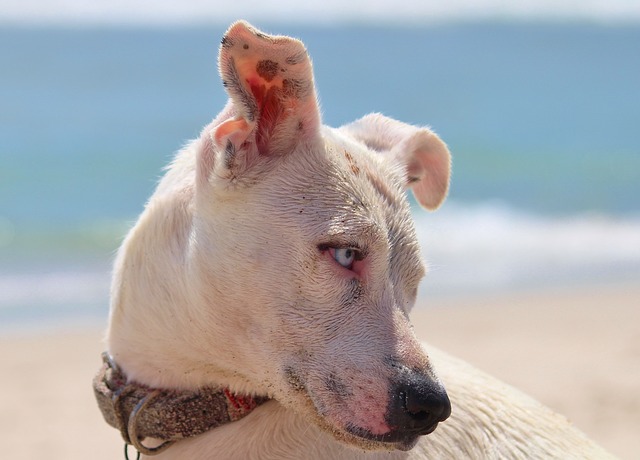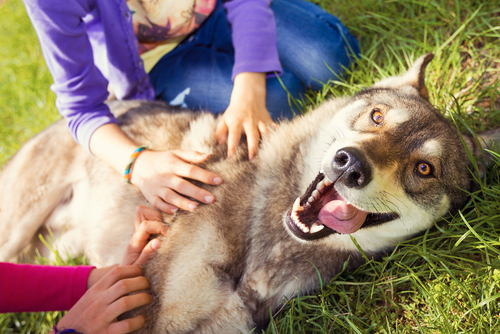
Did you know that growths on the skin are the most common type of tumor in dogs?
While not all of them are cancerous, the ones that are can be quite aggressive. It’s essential to understand the risk factors, symptoms, and protective measures related to dog skin cancer so you can better safeguard your pup.

What Are The Types Of Dog Skin Cancer?
There are three types of skin cancer commonly seen in dogs:
Malignant Melanoma
This type of cancer affects pigmented cells in the skin known as melanocytes. While many tumors that develop in these cells are benign, others grow quickly and metastasize to other areas of the body like the liver and/or lungs.
Benign melanomas, known as melanocytomas, are typically found on areas of the dog’s skin that have hair, whereas most malignant melanomas occur on or in the mouth. Trauma and compulsive licking may contribute to the rapid cell growth that causes melanomas, but genetics also seems to play a role.
Squamous Cell Carcinoma
These malignant tumors usually appear as raised white lumps on the skin, in the nail beds or the mouth. They’re often caused by sun exposure, but they may also be connected to the papillomavirus in certain dogs.
Mast Cell Tumors
These are the most common dog skin cancers. The exact cause of mast cell tumors is unknown, but they have been linked to inflammation, irritants on the skin, and genetic factors. The hormones estrogen and progesterone may also affect tumor growth.

What Are The Risk Factors?
Sun Exposure
As with humans, sun exposure is a factor in dog skin cancers. Even though most pups are covered in hair, the sun can still penetrate through the coat and cause damage to sparsely protected areas like the nose and ears. Hairless dogs and short-haired breeds are especially prone to excessive sun exposure.
Breed
Any dog can develop skin cancer, but the following breeds seem to have a genetic predisposition for certain types:
Malignant Melanomas occur most frequently in black dogs, especially Scottish Terriers and Schnauzers. Note: Vizslas, Miniature Schnauzers, Doberman Pinschers, Airedale Terriers, and Chesapeake Bay Retrievers are prone to benign (non-cancerous) melanomas.

What Are The Signs Of Dog Skin Cancer?
The visual signs of dog skin cancer vary depending on which form you are dealing with. Even veterinarians cannot always tell which masses are malignant and which are not, so it’s crucial to have any new or changing growths examined and biopsied.
That said, there are a few guidelines to help you identify a suspicious mass:
- Malignant Melanomas often occur on the lips, in the mouth, and on the nail beds and pads of the feet.
- Squamous Cell Carcinomas are wart-like in appearance and tend to occur on the abdomen, around the genitals, and less frequently on the feet.
- Mast cell tumors mostly appear on the trunk of the body and sometimes on the legs.

What Are The Treatment Options?
Dog skin cancers of all kinds are removed surgically on a case-by-case basis. However, if the tumor is in a difficult location or has spread to the lymph nodes, additional treatments such as chemotherapy, radiation, and oral medications may be necessary.
There is also a therapeutic DNA vaccine that causes the dog’s immune system to attack tumor cells. It has shown excellent results in extending the survival time of dogs with oral melanoma.
How Can I Protect My Dog From Skin Cancer?
Sunscreen
Dogs with thin hair coats and pale skin need more protection from the sun than their thicker-coated friends. However, don’t just grab any human grade sunscreen from the pharmacy, as some of these products can be toxic.
“Sunscreen contains zinc oxide and can be particularly damaging to a dog’s intestines if ingested. Eating these products can cause your dog to have bloody diarrhea and bloody vomit, which is indicative of intestinal damage,” says veterinarian, Rachel Barrack.
Instead, choose a sunscreen specifically designed for dogs. The product review site, Pet Life Today, features their picks for The 25 Best Dog Sunscreens of 2020.
Not sure if your dog needs sunscreen? Consult your veterinarian. Your vet can help you assess your dog’s risk, choose an appropriate product, and teach you how and when to use it.

Vigilance
Keep in mind that more than 50% of the lumps, bumps, and lesions dogs develop are non-cancerous and that aging dogs are especially prone to benign warts and cysts.
However, the only way to truly rule out dog skin cancer is a veterinary exam and a biopsy. Even if your dog’s growths are declared benign, it’s still important to monitor them for changes in size, color, discharge, etc. Staying vigilant with frequent at-home checks is the best way to help protect your pup.
H/T to WebMD Pets
The post Dog Skin Cancer: What Every Owner Should Know appeared first on iHeartDogs.com.
via Whisker Therapy